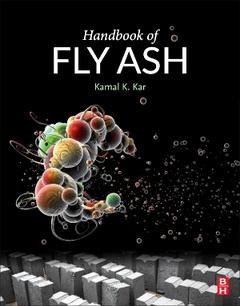Handbook of Fly Ash
Auteur : Kar Kamal K.

The drive to develop more sustainable materials has made fly ash a valuable raw material in many different applications. Comprehensive and authoritative, Handbook of Fly Ashhighlights the latest research efforts to develop the properties of fly ash to maximum utility while safeguarding the environment.
This book takes an interdisciplinary approach to the research into the classification and compositions of various types of fly ash, such as bottom ash and boiler slag, special classes of fly ash, and their sources around the globe. This is followed by a discussion of fly ash-reinforced composites, such as elastomer-based composites and metal matrix composites. This book also covers a wide range of applications of fly ash in cement, concrete, bricks and blocks, road construction, wastewater treatment, and scrubber sludge solidification.
Section A: Fly ash 1. Coal-based fly ash 2. Functionalization of fly ash 3. Fly ash cenosphere: characterization, processing, and properties 4. Fly ash: safety and health issues Section B: Composites 5. Fly ash-reinforced polyethylene composites 6. Fly ash-reinforced polypropylene composites 7. Fly ash-reinforced polyvinyl chloride composites 8. Fly ash-reinforced poly(vinyl alcohol) composites 9. Fly ash-reinforced acrylonitrile butadiene styrene composites 10. Fly ash-reinforced epoxy composites 11. Fly ash-reinforced polyester composites 12. Fly ash/glass fiber/carbon fiber-reinforced thermoset composites Section C: Applications 13. Extraction of unburned carbon from coal fly ash 14. Extraction of silicon in the form of nanoparticles and nanorods from coal fly ash 15. Soil stabilization 16. Phytoremediation of fly ash: bioaccumulation and translocation of metals in natural colonizing vegetation on fly ash lagoons 17. Effects of fly ash on growth, productivity, and diseases of crop plants 18. Fly ash cement 19. Fly ash in the construction industry 20. Application of fly ash in flowable fills and self-compacting concretes 21. Fly ash in road construction 22. Fly ash-mixed polymeric media for abrasive flow machining process 23. Electrochemical performance of elements derived from coal combustion fly ash for high-performance lithium-ion batteries 24. Polymer-metal/metal oxide-coated fly ash cenosphere composite film for electromagnetic interference shielding 25. Fly ash as a potential filler for the rubber industry 26. 3D printing of fly ash-based syntactic foams
- Highlights the recent developments in the utilization of fly ash including its preparation, functionalization, properties, and handling.
- Places a focus on a wide variety of fly ash applications including recent innovations, such as alkali-activated binder, polypropylene composite, and geopolymer concrete.
- Includes comprehensive coverage of the characteristics of fly ash with a particular focus on health hazards if it is not properly disposed.
- Discusses fly ash-reinforced composites, such as polymer/elastomer-based composites and metal matrix composites.
Date de parution : 11-2021
Ouvrage de 868 p.
15.5x23.3 cm
Thème de Handbook of Fly Ash :
Mots-clés :
?3D printing; AFM; Acid rain; Acrylonitrile butadiene styrene; Added value; Agriculture; Alkali activation; Alveolar macrophage; Amorphous; Angular lacy; Antibacterial; Application; Beneficiation; Cancer; Carbon fiber; Carbonaceous; Catalysis; Cementitious; Cenosphere; Central electricity authority; Ceramic; Characterizations; Chemical admixtures; Circular economy; Class C; Class F; Classification; Coal; Coal fly ash; Coalification; Cobalt naphthenate; Combustion; Composites; Composition; Concrete; Construction; Controlled low strength materials; Coupling agent; DNA damage; Denitrification; Depth separation; Dielectrics; Dynamic mechanical analysis; Electromagnetic interference shielding; Electrostatic precipitator; Energy; Environment; Epoxy; Epoxy resin; Ettringite; Filament manufacture; Filler; Flash cenosphere; Fluidized bed combustion; Fly ash; Fly ash (FA); Fly ash and surface finish; Fly ash cenosphere; Fly ash filled opencast mine voids; Fly ash mission; Fossil fuel; Froth floatation; Fuel; Fungi; Fused filament fabrication; Geoplymer cement; Glass fiber; Global; Granuloma; Groundwater contamination; Hardened state properties; Heavy metals; Hollow particle; Humification; Hydrochloric acid (HCl); Hydrophilic; Hydrophobic; Injection molding; Inorganic; Isothermal heating; Lithium-ion battery; Loss on ignition; Macerals; Management; Mechanical property; Mechanochemical activation; Metal nanoparticles; Methyl ethyl ketone peroxide; Microcompounder; Microinjection molding; Microwave absorption; Mineral; Minerals; Modeling; Morphology; Nanoparticles; Nanorods; Naturally colonizing vegetation; Nematodes; Nonopaque



